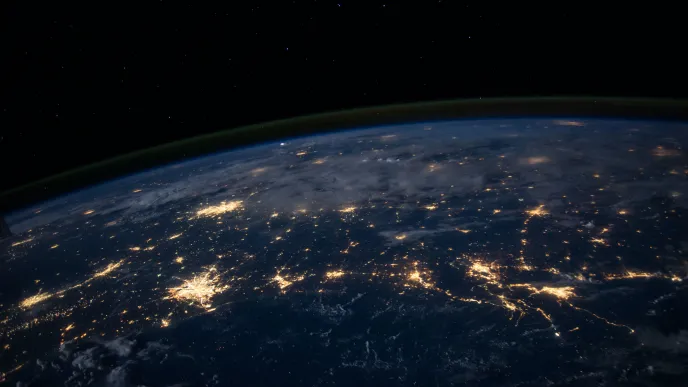The hydrogen economy is a burning issue that is being scrutinized from many an angle. All the hype around the phenomenon has the uninitiated thinking that it has only recently emerged. LUT’s Associate Professor Antti Kosonen says this is not the case.
”We have actually always been living in a hydrogen economy: hydrogen is the world’s oldest and most common chemical element, and the traditional energy industry has been based on hydrocarbons. Oil and other fossil energy sources are hydrocarbons where hydrogen is the energy carrier,” Kosonen explains.
Although the dialogue around energy issues tends to stir up strong emotions and pit opposing views against each other, the necessity to shift away from fossil fuels is widely acknowledged.
”Energy production based on burning must come to an end and finding substitutes for fossil raw materials is essential. There is broad consensus on that, but opinions differ on the means,” Kosonen says.
”From here on out, we must produce the energy we need ourselves, and we must do it as efficiently as possible. Energy conversion will take place through electrification,” Kosonen elaborates.
Affordable, clean electricity is the key to the energy reform
The energy industry both in Finland and globally is looking to hydrogen as a solution for cases that are difficult to decarbonize. Hydrogen enters the picture in the electrification of transportation, heat production and industrial manufacture, which currently have significant negative environmental impacts.
Electrification simply means substituting fossil fuels with electricity as the power source in energy, heat and material production. Carbon-neutral production is possible when the electricity is generated in an emission-free manner, such as with wind or solar power.
”Shifting from fossil energy sources to electricity is the name of the game. Electricity can be stored or converted chemically to other goods. We need to ensure the availability of clean, low-cost electricity – this is the key idea of the hydrogen economy,” says Petteri Laaksonen, research director at the LUT School of Energy Systems.
Laaksonen says that by 2050, up to 80% of all global energy investments are expected to focus on solar and wind power, which will be the essential energy sources in the future. LUT’s researchers have repeatedly called for the removal of all obstacles from the extended construction of wind farms in Finland.
In Eastern Finland and the country’s southern coast, the construction of wind farms is restricted because they distract radar surveillance on the national border.
”Electricity consumption should admittedly be curbed wherever possible, and energy efficiency should be further developed. However, achieving zero emissions will anyway require wide-scale electrification. This means the demand for electricity will multiply, and it would be senseless not to produce it domestically,” maintains Laaksonen.
Laaksonen describes the transformation of the energy system as radical: ”The future energy system will become more complicated when different industry sectors and commodities are linked more strongly with each other. Business models and earnings logics will need to be rethought, and regional differences in regulation and legislation will influence the big picture more than in the current system. In addition to technology and business models, LUT aims to understand regulation.”
Direct and indirect electrification complement each other
Antti Kosonen emphasizes that all processes that can be electrified directly should be electrified: ”The so-called hydrogen route – producing emission-free hydrocarbons to replace fossil fuels – is only a secondary solution where direct electrification is impossible.”
The most obvious example of electrification is probably transportation.
”Nearly all areas of transportation can be fully electrified with current technologies – and at a low cost compared to fossil fuels. Electric motors are often highly efficient,” says Petteri Laaksonen.
Laaksonen goes on to say that the most difficult areas of transportation to electrify directly are heavy maritime transport and air transport. An indirect pathway to the electrification of transportation is provided by so-called e-fuels. Their production has been piloted at LUT already in 2017.

Electrification of fuel production, chemical industry and heating
”Power-to-x technologies enable using hydrogen and carbon dioxide to produce carbon-neutral fuels, such as synthetic methanol and kerosine refined from it. The production can utilize surplus hydrogen from industrial processes. Another alternative is water electrolysis, which requires a great deal of electrical energy, but when the electricity is based on renewable sources, production is emission-free,” outlines Laaksonen.
Together with its partners, LUT has explored possibilities to set up a pilot plant for synthetic fuels in Joutseno, Finland. According to the researchers and business partners who contributed to the study, the starting point for setting up the plant is good. Olli Pyrhönen, dean of the LUT School of Energy Systems, explains that synthetic methanol could enable the overall decarbonization of Finnish transport and industrial production, detaching them from fossil energy sources.
”The energy content of methanol originates from hydrogen, which could be described as a modern, emission-free version of crude oil. It can replace many fossil raw materials. Nothing prevents decarbonizing not only transportation but all of industry. The technology is already there,” says Pyrhönen, who led the research.
The Finnish industrial application of hydrogen that has drawn the most attention has been SSAB’s plan to replace coal with hydrogen in steelmaking.
Also, products refined by the chemical industry from fossil raw materials can be prepared with synthetic methanol.
”The volumes in the chemical industry – in fertilizer production, for example – are very high. The Joutseno study provided companies beyond the transportation fuel industry with valuable data on the possibilities to replace raw materials such as crude oil with methanol,” says Pyrhönen.
LUT has also conducted research on power-to-x applications and electrification in the heating of buildings.
“Compared to electricity, burning is an inefficient way to produce heat. It can be up to ten times more efficient to heat buildings with electricity. If enough low-cost electricity is available, I’m convinced buildings will soon be largely cooled and heated with electricity,” Laaksonen analyses.
Hydrogen economy – facts and background
- Hydrogen is the world’s most common element, and the traditional energy industry has been based on hydrocarbons.
- Hydrogen is a fuel, raw material and energy storage.
- Through electrification, hydrogen can replace fossil raw materials.
- Electrification refers to the transition from fossil fuels to electricity as an energy source in the production of energy, heat and materials.
- Direct electrification solutions include, for instance, electric vehicles powered by an electric motor instead of an internal combustion engine.
- Indirect electrification refers to, for example, the production of electric fuels – that is, emission-free hydrocarbons that can replace fossil fuels. In addition to hydrogen, the process requires carbon dioxide from the atmosphere or industrial emissions.
- The production of green hydrogen is based on water electrolysis with renewable electricity, which does not release emissions.
- Blue hydrogen is produced from a fossil source, but the carbon dioxide emitted in the process is recovered instead of released into the atmosphere.
- The availability and affordability of clean electricity is the key to a hydrogen economy.
Blue or green hydrogen? Raw material, fuel or energy storage?
Hydrogen is currently obtained mostly by reforming fossil natural gas – a process that releases a great deal of carbon dioxide emissions. However, hydrogen is often referred to as emission-free and classified as blue or green. What do these colours signify?
”Hydrogen is blue when it is produced from a fossil source, but the carbon dioxide emissions from the process are recovered instead of releasing them into the atmosphere. Green hydrogen production, in contrast, is based on water electrolysis utilizing electricity from renewable sources, which means the process generates no emissions,” Antti Kosonen clarifies.
Another aspect that may confuse the layperson is the fact that hydrogen is referred to as a raw material, fuel and energy storage.
”Hydrogen is actually all of these. In processes based on power-to-x technology, hydrogen may be a raw material. For example, fuel cells in hydrogen cars use hydrogen and oxygen to produce energy that makes the vehicle move,” explains Kosonen.
Whereas batteries are a daily energy storage, hydrogen can serve as a seasonal energy storage. Since the availability of wind and solar power fluctuates seasonally, it is more feasible to store such energy in hydrogen through electrolysis. “That is often more sensible than dimensioning batteries according to production peaks.”
Of course, the above requires energy-efficient design and equipment, optimizing solar panels, batteries, electrolysis devices and fuel cells in relation to each other. Kosonen’s own home in Imatra, Finland, proves that as highlighted even in a scientific paper.
”Hydrogen’s low density makes it difficult to store because it takes up a great deal of space. Therefore, hydrocarbon chains derived from hydrogen are a more appealing hydrogen storage method,” Kosonen points out.
Could Finland be an energy self-sufficient fuel exporter?
Germany is considered the leading country in the development of a hydrogen economy, but many consider Finland a surprisingly influential actor in the field considering the country’s size. Finland has no separate hydrogen strategy, but Finland’s national hydrogen roadmap from 2020 mentions that the country has significant potential in the production of synthetic fuels, the cost-efficient and low-carbon production of hydrogen, low-carbon steel production, and cutting industrial logistics costs.
LUT’s experts are bold and optimistic in their assessments.
”In my opinion, Finland could be energy self-sufficient. At the moment, Finland imports energy for about a million euros an hour and eight billion euros a year, but we do not need to keep going like this,” Antti Kosonen claims.
Kosonen hopes Finland would quickly calculate what it would take for the national economy to become self-sufficient in terms of energy.
”We are no longer living in a world where we need to import fossil energy. We can produce the energy we need ourselves. This would create new jobs and exportable competence. The key technologies already exist, as does the possibility for their global demand. We should now focus on scaling and related research investments,” Kosonen continues.
LUT’s research especially supports lowering the costs of power-to-x technologies and building related business models that enable seizing opportunities provided by new technologies. Kosonen himself is a project manager on the P2XEnable research project and conducts research on how the quality of electricity affects the efficiency of the electrolysis process.
”In my opinion, the domestic market in Finland could be a platform for testing entities composed by technical solutions, business and distribution. This would provide tested concepts for export. Finland’s investments in bio-based solutions have been historically understandable, but on a global scale, bio-based solutions do not enjoy a similar demand as power-to-x concepts,” says Kosonen.
”In my opinion, the domestic market in Finland could be a platform for testing entities composed by technical solutions, business and distribution. This would provide tested concepts for export. Finland’s investments in bio-based solutions have been historically understandable, but on a global scale, bio-based solutions do not enjoy a similar demand as power-to-x concepts,” says Kosonen.
Like Kosonen, also Petteri Laaksonen paints a picture of the Finnish energy future with bold strokes.
”Finland could become an exporter of fuel even though many don’t believe it yet,” envisions Laaksonen.
Laaksonen is a research director in several hydrogen economy research projects and LUT’s representative in national committees. In addition to technological expertise, Finland has an ace up its sleeve: favourable wind conditions and sparse population.
”The demand for kerosine alone is 300 million tons a year, and it’s only a matter of years before someone introduces an emission-free alternative to the market. Finland could produce twice the amount of transport fuels it consumes nationally and export the rest,” Laaksonen believes.
LUT is putting the finishing touches on a report on the utilization of the extensive wind power potential in the Åland Islands. According to Laaksonen, Åland is a perfect example of the special characteristics of the Nordic countries.
“The possibilities for producing clean energy are excellent in terms of the climate and available square footage. Reports indicate that electricity should be further processed as close to the production site as possible. In other words, we should produce ready-to-use e-fuel and export the end product,” Laaksonen concludes.

More information

Antti Kosonen

Petteri Laaksonen






